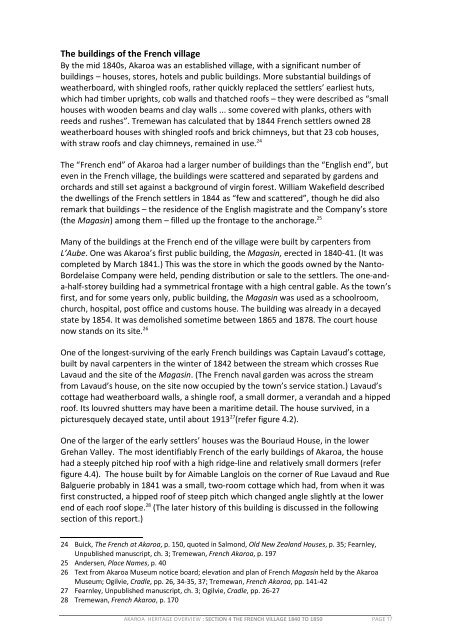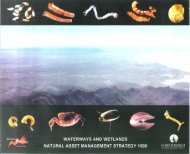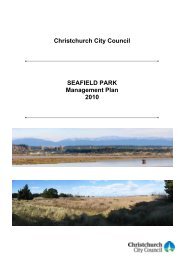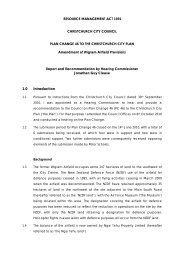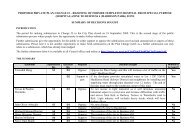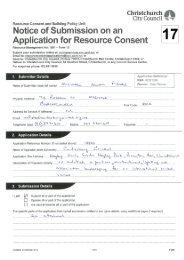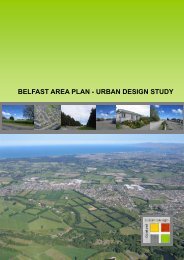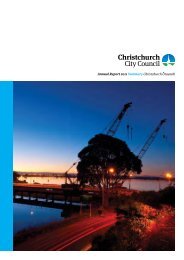Akaroa Historical Overview - Christchurch City Council
Akaroa Historical Overview - Christchurch City Council
Akaroa Historical Overview - Christchurch City Council
You also want an ePaper? Increase the reach of your titles
YUMPU automatically turns print PDFs into web optimized ePapers that Google loves.
The buildings of the French village<br />
By the mid 1840s, <strong>Akaroa</strong> was an established village, with a significant number of<br />
buildings – houses, stores, hotels and public buildings. More substantial buildings of<br />
weatherboard, with shingled roofs, rather quickly replaced the settlers’ earliest huts,<br />
which had timber uprights, cob walls and thatched roofs – they were described as “small<br />
houses with wooden beams and clay walls ... some covered with planks, others with<br />
reeds and rushes”. Tremewan has calculated that by 1844 French settlers owned 28<br />
weatherboard houses with shingled roofs and brick chimneys, but that 23 cob houses,<br />
with straw roofs and clay chimneys, remained in use. 24<br />
The “French end” of <strong>Akaroa</strong> had a larger number of buildings than the “English end”, but<br />
even in the French village, the buildings were scattered and separated by gardens and<br />
orchards and still set against a background of virgin forest. William Wakefield described<br />
the dwellings of the French settlers in 1844 as “few and scattered”, though he did also<br />
remark that buildings – the residence of the English magistrate and the Company’s store<br />
(the Magasin) among them – filled up the frontage to the anchorage. 25<br />
Many of the buildings at the French end of the village were built by carpenters from<br />
L’Aube. One was <strong>Akaroa</strong>’s first public building, the Magasin, erected in 1840-41. (It was<br />
completed by March 1841.) This was the store in which the goods owned by the Nanto-<br />
Bordelaise Company were held, pending distribution or sale to the settlers. The one-anda-half-storey<br />
building had a symmetrical frontage with a high central gable. As the town’s<br />
first, and for some years only, public building, the Magasin was used as a schoolroom,<br />
church, hospital, post office and customs house. The building was already in a decayed<br />
state by 1854. It was demolished sometime between 1865 and 1878. The court house<br />
now stands on its site. 26<br />
One of the longest-surviving of the early French buildings was Captain Lavaud’s cottage,<br />
built by naval carpenters in the winter of 1842 between the stream which crosses Rue<br />
Lavaud and the site of the Magasin. (The French naval garden was across the stream<br />
from Lavaud’s house, on the site now occupied by the town’s service station.) Lavaud’s<br />
cottage had weatherboard walls, a shingle roof, a small dormer, a verandah and a hipped<br />
roof. Its louvred shutters may have been a maritime detail. The house survived, in a<br />
picturesquely decayed state, until about 1913 27 (refer figure 4.2).<br />
One of the larger of the early settlers’ houses was the Bouriaud House, in the lower<br />
Grehan Valley. The most identifiably French of the early buildings of <strong>Akaroa</strong>, the house<br />
had a steeply pitched hip roof with a high ridge-line and relatively small dormers (refer<br />
figure 4.4). The house built by for Aimable Langlois on the corner of Rue Lavaud and Rue<br />
Balguerie probably in 1841 was a small, two-room cottage which had, from when it was<br />
first constructed, a hipped roof of steep pitch which changed angle slightly at the lower<br />
end of each roof slope. 28 (The later history of this building is discussed in the following<br />
section of this report.)<br />
24 Buick, The French at <strong>Akaroa</strong>, p. 150, quoted in Salmond, Old New Zealand Houses, p. 35; Fearnley,<br />
Unpublished manuscript, ch. 3; Tremewan, French <strong>Akaroa</strong>, p. 197<br />
25 Andersen, Place Names, p. 40<br />
26 Text from <strong>Akaroa</strong> Museum notice board; elevation and plan of French Magasin held by the <strong>Akaroa</strong><br />
Museum; Ogilvie, Cradle, pp. 26, 34-35, 37; Tremewan, French <strong>Akaroa</strong>, pp. 141-42<br />
27 Fearnley, Unpublished manuscript, ch. 3; Ogilvie, Cradle, pp. 26-27<br />
28 Tremewan, French <strong>Akaroa</strong>, p. 170<br />
AKAROA HERITAGE OVERVIEW : SECTION 4 THE FRENCH VILLAGE 1840 TO 1850 PAGE 17


